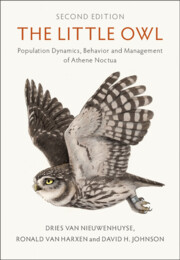Book contents
- The Little Owl
- The Little Owl
- Copyright page
- Contents
- Foreword
- Preface
- Acknowledgements
- Executive Summary
- Chapter 1 Introduction: Framework
- Chapter 2 History and Traditions
- Chapter 3 Fossil Evidence, Taxonomy and Genetics
- Chapter 4 Morphology and Body Characteristics
- Chapter 5 Distribution, Population Estimates and Trends
- Chapter 6 Habitat
- Chapter 7 Diet
- Chapter 8 Breeding Season
- Chapter 9 Behavior
- Chapter 10 Population Regulation
- Chapter 11 Management and Conservation
- Chapter 12 Research Priorities
- References
- Index
Chapter 10 - Population Regulation
Published online by Cambridge University Press: 29 September 2023
- The Little Owl
- The Little Owl
- Copyright page
- Contents
- Foreword
- Preface
- Acknowledgements
- Executive Summary
- Chapter 1 Introduction: Framework
- Chapter 2 History and Traditions
- Chapter 3 Fossil Evidence, Taxonomy and Genetics
- Chapter 4 Morphology and Body Characteristics
- Chapter 5 Distribution, Population Estimates and Trends
- Chapter 6 Habitat
- Chapter 7 Diet
- Chapter 8 Breeding Season
- Chapter 9 Behavior
- Chapter 10 Population Regulation
- Chapter 11 Management and Conservation
- Chapter 12 Research Priorities
- References
- Index
Summary
Little Owls have been shown to be directly and indirectly affected by habitat loss, vehicle collisions, limited availability of nest and roosting sites, pesticides (i.e., secondary poisoning) and heavy metals, entrapment in anthropogenic structures (i.e., hollow metal power poles and chimneys, and drowning in water troughs), predators and weather. They are susceptible to parasites, diseases and injuries too. While the Little Owl has co-evolved with a few of these (e.g., weather, predators, diseases, parasites), anthropogenic activities have substantially altered the landscape within which Little Owls exist(ed). When the population grows and owl densities become higher, density-dependent processes take place and serve to stabilise the population. In a metapopulation context, as populations become increasingly small, immigration helps to support them, extending the survival time of these population clusters. The mating system hypothesis, which predicts that the sex that establishes the territory should disperse shorter distances, was studied using the EURING data set containing 108 444 observations of ringing, re-capture and recovery data for 59 743 unique ringed birds. Little Owls ringed as young and recovered at least one year later dispersed on average 14.69 km for females, 6.47 km for males and 11.61 km for birds with unknown sex for live re-captures. Birds ringed as adults and then later recovered dispersed 2.33 km for females, 2.45 km for males and 2.42 km for birds with unknown sex for live re-captures.
Keywords
- Type
- Chapter
- Information
- The Little OwlPopulation Dynamics, Behavior and Management of <I>Athene noctua</I>, pp. 405 - 479Publisher: Cambridge University PressPrint publication year: 2023



